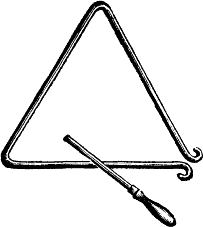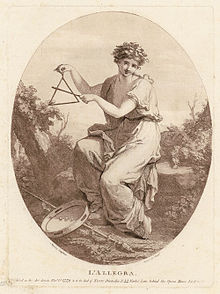Triangle (musical instrument): Difference between revisions
No edit summary |
Tag: repeating characters |
||
| Line 47: | Line 47: | ||
==External links== |
==External links== |
||
the triangle goes ting!!!!!!!!!!!!!!! |
|||
==Notes== |
==Notes== |
||
Revision as of 23:50, 23 July 2009
 | |
| Classification | Hand percussion, idiophone |
|---|---|
| Playing range | |
| Single note, open and closed | |


The triangle is an idiophone type of musical instrument in the percussion family. It is a bar of metal, usually steel in modern instruments, bent into a triangle shape. Usually held by a string at the top curve.
Shaping
On a triangle instrument, one of the angles is left open, with the ends of the bar not quite touching. This causes the instrument to be of indeterminate or not settled or decided pitch. It is either suspended from one of the other corners by a piece of thin wire or gut, leaving it free to vibrate, or hooked over the hand. It is usually struck with a metal beater, giving a high-pitched, ringing tone.
Although the shape is nowadays generally in the form of an equilateral triangle, early instruments were often formed as isosceles triangles. In the early days the triangles had jingling rings along the lower side.
Origin
The exact origins of the triangle instrument are unknown, but a number of paintings from the Middle Ages depict the instrument being played by angels, which has led to the belief that it played some part in church services at that time. Other paintings show it being used in folk bands. The triangle started appearing in marching bands as early as the 1700s.
Use and technique
In folk music, samba and rock music a triangle is more often hooked over the hand so that one side can be damped by the fingers to vary the tone. The pitch can also be modulated slightly by varying the area struck and by more subtle damping.
The triangle (known in Cajun French as a tit-fer) is popular in Cajun music where it serves as the strong beat, especially if no drums are present.[1]
In European classical music, the triangle has been used in the western classical orchestra since around the middle of the 18th century. Wolfgang Amadeus Mozart, Joseph Haydn and Ludwig van Beethoven all used it, though sparingly, usually in imitation of Janissary bands. The first piece to make the triangle really prominent was Franz Liszt's Piano Concerto No. 1, where it is used as a solo instrument in the third movement, giving this concerto the nickname of "triangle concerto". In the 19th century, the triangle was used in some music by Richard Wagner, such as the "Bridal chorus" from "Lohengrin" (opera). [2]
When ignoring pitch modulation and damping, the triangle appears to require no specialist ability to play and is often used in jokes and one liners as an archetypal instrument that requires no skill to play. The Martin Short sketch comedy character Ed Grimley is the best known example. However, triangle parts in classical music can be very demanding, and James Blades in the Grove Dictionary of Music and Musicians writes that "the triangle is by no means a simple instrument to play". In the hands of an expert it can be a surprisingly subtle and expressive instrument.
Most difficulties in playing the triangle come from the complex rhythms which are sometimes written for it, although it can also be quite difficult to control the level of volume. Very quiet notes can be obtained by using a much lighter beater — knitting needles are sometimes used for the quietest notes. Composers sometimes call for a wooden beater to be used instead of a metal one, which gives a rather "duller" and quieter tone.
Historically, it has been used to symbolize that dinner is ready.
Triangle in Popular Culture
A notable player of the triangle is John Deacon of the rock group Queen. He would play the triangle in live performances of Killer Queen, hanging it from his microphone.
It can be heard in short breaks on the Joni Mitchell song "Big Yellow Taxi". Noted zydeco musician Alphonse "Bois Sec" Ardoin started his musical training on the triangle as a child.
The percussionist with the Foo Fighters was given a 20 second Triangle solo in front of 85,000 people each night when the band played Wembley Stadium on the 6th & 7th of June 2008.
Other notable triangle players include newcomer Moody Mascott from the new wave / minimalist German French pop group Kommando Trash. Kommando Trash's 52nd track listen, appreciate is entirely dedicated to the beautiful sounds of the triangle.
External links
the triangle goes ting!!!!!!!!!!!!!!!
Notes
- ^ "Louisiana Voices Glossary" (Under definition for Tit-fer). Retrieved 2008-03-08.
- ^ "OUP: Richard WAGNER (1813-1883)" (instruments used), Oxford University Press, 2006, webpage: OUPcoUK-Wagner.

